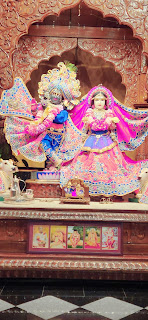Friday, January 20th, 2023
Brampton, Ontario
Nanda took Nikhil and I for a walk at Chinguacousy Park in Brampton. Also, I went to the dentist. The not-good-news is the bridge of my teeth is cracked and needs replacing.
The following is a poem about some of the history of mistreatment of the female sector in the movement. There is an attempt to rectify.
GENDER BLENDER
Early 70s, the Hare Krishna Movement
North America enjoyed a great recruitment
We were a growing, glowing family
A blessed bunch existing happily
Prabhupada’s “boys and girls” flourished
Under his mercy we were nourished
The temple room was a divided place
Both genders occupied equal space
Both dhotis and sarees were there at prayer
And basically duties were a joyful share
From puja to cooking, chanting, books, fundraising
The focus was Krishna receiving the praising
Then something took us all by surprise
A storm came–blurred vision–blocked eyes
An insidious force attempted a major divide
Many members were forced to take sides
Women were marginalized, family men too
It was horrible and evolved as a nasty feud
Our father was alerted to the problem
Daughters being bullied becoming quite common
Protective as he was, he put his foot down
The vilifiers practically had to leave town
Justice done but we never recovered
An attitude pervaded, offending our mothers
They surrendered their lives just like their bros
Giving their everything, they cannot be foes
June 1976, The Hare Krishna Movement
In many areas there was growth, improvement
In Toronto Professor O’Connell had inquired
About female gurus who are so inspired
Prabhupada’s response was “yes”, “some” – approved!
Current leaders approved, then the “yes” was removed
I reflect on this continued bout, lump in throat
Restricting such talent makes bhakti quite remote
Encouragement has always been a major component
In our tradition of love without the label ‘opponent’
Where I live in the male-bashing fatherless west
It registers as hurtful when fine masculine values are lost
Do we want to leave a history of the gender reverse
Where cultural sensitivity was thrown in a hearse?
Let us submit to a wiser and kinder inclusion
Unity and diversity is an absolute conclusion
–By Bhaktimarga Swami
May the Source be with you!



































